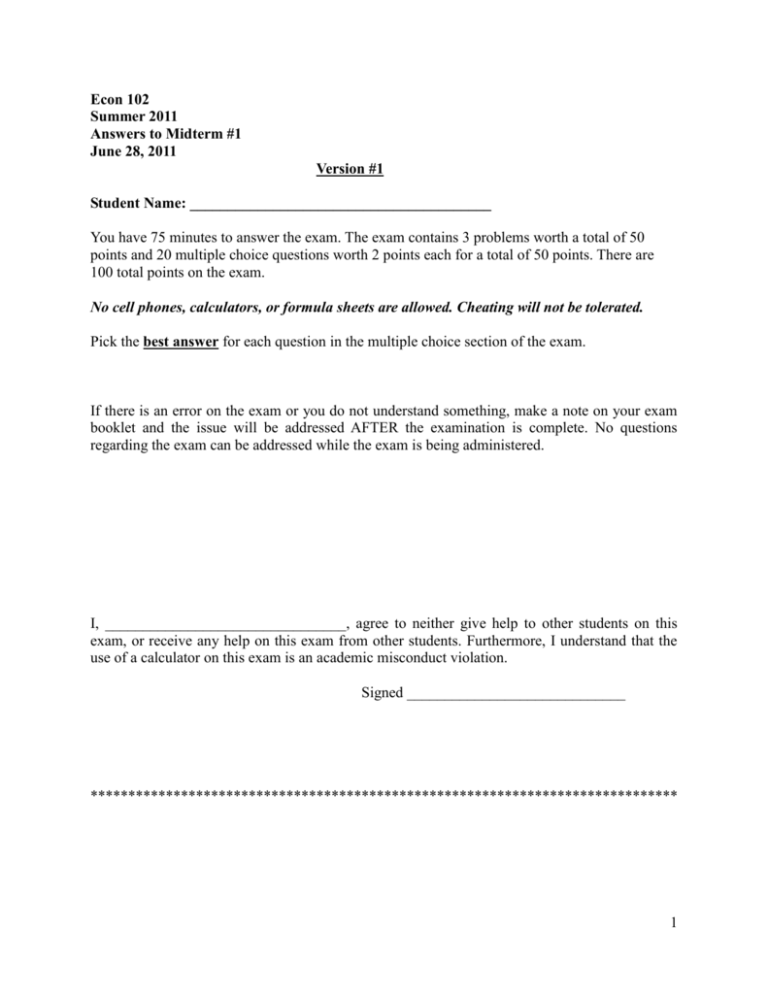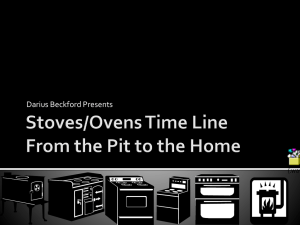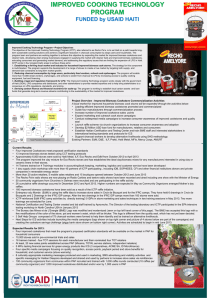Answers to First Midterm
advertisement

Econ 102 Summer 2011 Answers to Midterm #1 June 28, 2011 Version #1 Student Name: ________________________________________ You have 75 minutes to answer the exam. The exam contains 3 problems worth a total of 50 points and 20 multiple choice questions worth 2 points each for a total of 50 points. There are 100 total points on the exam. No cell phones, calculators, or formula sheets are allowed. Cheating will not be tolerated. Pick the best answer for each question in the multiple choice section of the exam. If there is an error on the exam or you do not understand something, make a note on your exam booklet and the issue will be addressed AFTER the examination is complete. No questions regarding the exam can be addressed while the exam is being administered. I, ________________________________, agree to neither give help to other students on this exam, or receive any help on this exam from other students. Furthermore, I understand that the use of a calculator on this exam is an academic misconduct violation. Signed _____________________________ ****************************************************************************** 1 I. Problems (3 problems worth 50 points each) 1. (20 total points)You are told that there are two consumers in a market. The demand curve for each consumer is given below: Demand for Consumer One: P = 10 – Q Demand for Consumer Two: P = 5 – Q You are also told that the market supply curve is initially P = (1/2)Q. But, the market supply curve is no longer in its initial position: at every price the quantity supplied has increased by 5 units. a. (8 points) Draw a series of graphs in the space below that represent the demand for consumer one, the demand for consumer two, and the market demand. There should be three separately labeled graphs. All intercepts should be numerically labeled, all kinks in the demand curve should be numerically labeled, all axes should be clearly labeled, and each graph should be clearly titled. Answer: b. (4 points) Find the market demand curve given that there are two demanders in this market. If necessary provide the relevant range of prices for each segment of the demand curve. Answer: For P > or = to 5, P = 10 – Q For P < or = to 5, P = 7.5 – (1/2)Q c. (2 points) Find the new supply equation for this market given the above information. Answer: Initial supply equation is P = (1/2)Q. New supply curve has the quantity supplied increasing 2 by 5 units at every price. Thus, the when price is equal to 2, the new quantity supplied is 9 units. When price is equal to 10, the new quantity supplied is 25 units. We can write this new supply curve as P = (1/2)Q – 2.5. Let’s check to make sure our two points are on this supply curve: P = (1/2)9 – 2.5 gives us a price of 2; P = (1/2)(25) – 2.5 gives us a price of 10. Both points are on the new supply curve. d. (2 points) Find the equilibrium price and quantity in this market given the above information. Show your work. Answer: The relevant demand curve is P = 7.5 – (1/2)Q and the supply curve is P = (1/2)Q – 2.5. Use these two equations to find the equilibrium price and quantity. 7.5 – (1/2)Q = (1/2)Q – 2.5 10 = Q P = 7.5 – (1/2)(10) = 2.5 Or, P = (1/2)(10) – 2.5 = 2.5 e. (2 points) Calculate the value of producer surplus in this market. Show your work. Answer: Producer Surplus (PS) is the sum of the area of a rectangle and the area of a triangle. PS = (2.5)(5) + (1/2)(2.5)(5) = $18.75 f. (2 points) Calculate the value of consumer surplus in this market. Show your work. Answer: Consumer Surplus (CS) is the sum of the area of two triangles plus a rectangle. CS = (1/2)(5)(5) + (2.5)(5) + (1/2)(2.5)(5) = $31.25 2. (15 points total) Suppose that the market for stoves in the small, closed economy of Camelot can be described by the following domestic demand and domestic supply equations: Domestic Demand: P = 1000 – 2Q Domestic Supply: P = 200 + 2Q a. (1 point) Calculate the equilibrium price and quantity in the market for stoves in Camelot if this market is closed to trade. Show your work. Answer: 1000 – 2Q = 200 + 2Q 4Q = 800 Q = 200 P = 1000 – 2Q = 1000 – 2(200) = 600 Or, P = 200 + 2(200) = 600 3 b. (2 points) Calculate the value of consumer surplus (CS) and producer surplus (PS) in the market for stoves in Camelot is this market is closed to trade. Show your work. Answer: CS = (1/2)(1000 – 600)(200) = (200)(200) = $40,000 PS = (1/2)(600 – 200)(200) = (200)(200) = $40,000 c. (2 points) Suppose that the world price of stoves is equal to $700. Determine whether or not Camelot will import or export stoves if Camelot opens its stove market to trade. Provide a numeric measure of these imports or exports. Answer: If the world price is $700 and Camelot opens its stove market to trade, then 150 stoves will be demanded domestically at that price while 250 stoves will be supplied domestically at that price. The excess supply of 100 stoves will be exported to the world market. d. (2 points) Suppose that the world price of stoves is equal to $700 and Camelot opens its stove market to trade. Do domestic consumers or domestic producers benefit more from this decision? Explain your answer. Answer: When the world price of stoves is $700 and Camelot opens its market to trade this results in Camelot exporting stoves. This tells us that domestic producers benefit from the opening of this market since they are now able to sell more stoves. We can see this gain from trade for domestic producers when we calculate their new producer surplus. When stoves sell for $700, the PS in Camelot is equal to (1/2)(700 – 200)(250) = $62,500. This is greater than the PS when the market is closed to trade (PS in part b was equal to $40,000). CS is smaller with trade: CS before trade was $40,000 and after trade it is equal to $22,500. e. (4 points) Suppose that the world price of stoves is equal to $300 and Camelot opens its stove market to trade. In addition Camelot imposes a quota of 150 stoves. Calculate the new price of stoves in Camelot and the license holder revenue that results from the imposition of this quota. Answer: With the quota we know that Qs + quota = Qd. We can rewrite the supply curve as Qs = (1/2)P – 100 and the demand curve as Qd = 500 – (1/2)P. Using these two equations we have: (1/2)P – 100 + 150 = 500 – (1/2)P. This can be solved as P = 450. License holder revenue is equal to ($450/stove - $300/stove)(150 stoves) = $22,500. f. (2 points) The policymakers in Camelot are debating the merits of a tariff versus a quota in the market for stoves. If the world price of stoves is $300, what would the tariff need to be in order for the tariff to be equivalent to the quota described in part (e)? Explain your answer. Answer: The quota raised the price of stoves from $300 to $450 in Camelot. A tariff of $150 would 4 result in the same effect: when the price of stoves rises from $300 to $450, the level of stove imports changes from 300 stoves imported to 150 stoves imported. To see this, substitute a price of $450 into both the demand and supply equations to find how many stoves are domestically demanded at this price and how many stoves are domestically supplied at this price. Thus, Domestic demand: P = 1000 – 2Qd or 450 = 1000 – 2Qd or Qd = 275 Domestic supply: P = 200 + 2Qs or 450 = 200 + 2Qs or Qs = 125 When the price is increased to $450 per stove, the level of stove imports is equal to 150 units. g. (2 points) Suppose that in Camelot the market for stoves is open to trade and that the world price is $300. For each of the following statements mark the statement as “T” for true or “F” for false. i. ______ Opening the stove market to trade increases total surplus. ii. ______ Opening the stove market to trade increases consumer surplus. iii. ______Opening the stove market to trade results in deadweight loss. iv. ______Opening the stove market to trade decreases producer surplus. Answers: i. True: the total area of PS + CS is greater with trade than when the economy is closed to trade. ii. True: Since the world price is below the equilibrium price, opening to trade will increase the area of CS. iii. False: With international trade there is no deadweight loss. iv. True: Since the world price is below the equilibrium price, opening to trade will decrease the area of PS. 3. (15 points) Capriland and Utopia both produce tires and shovels. Below is a table providing information about the amount of labor that the two countries use to produce these two goods. Amount of Labor to Produce Amount of Labor to Produce One Tire One Shovel Capriland 2 hours 4 hours Utopia 3 hours 4 hours Assume that the production possibility frontiers for both Capriland and Utopia are linear and that both countries have 240 hours of labor that can be devoted to the production of tires and shovels. a. (2 points) What is the maximum amount of tires that Capriland can produce given the above information? Answer: Capriland can produce one tire in 2 hours: with 240 hours of labor, Capriland can produce 120 tires. 5 b. (2 points) What is the maximum amount of shovels that Utopia can produce given the above information? Answer: Utopia can produce one shovel in 4 hours: with 240 hours of labor, Utopia can produce 60 shovels. c. (2 points) Write an equation in slope intercept form that expresses the relationship between shovels (S) and tires (T) for Utopia. Assume that shovels are measured on the vertical axis of Utopia’s production possibility frontier. Answer: S = 60 – (3/4)T d. (2 points) Write an equation in slope intercept form that expresses the relationship between shovels (S) and tires (T) for Capriland. Assume that shovels are measured on the vertical axis of Capriland’s production possibility frontier. Answer: S = 60 – (1/2)T e. (2 points) Which country has the comparative advantage in the production of shovels? Explain your answer. Answer: Utopia has the comparative advantage in the production of shovels since the opportunity cost of producing one shovel is 4/3 tires in Utopia while the opportunity cost of producing one shovel is 2 tires in Capriland. Utopia ha a lower opportunity cost of producing shovels. f. (2 points) Provide a range of trading prices for 10 tires in terms of shovels. Answer: One tire will trade between ½ shovel and ¾ shovel. Ten tires will trade between 5 shovels and 7.5 shovels. g. (3 points) Draw a graph in the space below that depicts the combined production possibility frontier for Capriland and Utopia if they trade with one another. Label your graph carefully and completely. If your PPF is composed of different segments, provide numeric values for any segment endpoints including the x and y intercepts. Answer: 6 II. Multiple Choice (25 questions each worth 2 points for a total of 50 points) 1. Use the following information to answer the next four (4) questions. You are given the following information about Beeland’s production possibility frontier (PPF). Beeland’s PPF is linear between points A and B, points B and C, points C and D, etc. Beeland has a fixed amount of resources and technology available to produce either guns or butter. Production Point A B C D E F Number of Guns 700 600 400 200 100 0 Pounds of Butter 0 200 400 450 475 500 1. Which of the above production points sit on the same linear segment of the PPF? a. Production points A, B and C b. Production points C, D, and E c. Production points B, C, and D d. Production points A, E, and F 2. Suppose this economy is producing at production point C initially. What is the opportunity cost of producing 100 additional guns? a. 100 pounds of butter b. 200 pounds of butter c. 50 pounds of butter d. 50 guns 3. Given the above information, which of the following statements is true? a. The law of increasing opportunity costs is true for the production of guns but is not true for the production of butter. b. The law of increasing opportunity costs is true for the production of guns as well as the 7 production of butter. c. The law of increasing opportunity costs is true for the production of butter but is not true for the production of guns. d. The provided information is not sufficient to answer this question. 4. Which of the following production combinations is not feasible given the above information? a. 650 guns, 100 pounds of butter b. 500 guns, 300 pounds of butter c. 384 guns, 404 pounds of butter d. 198 guns, 454 pounds of butter 5. Suppose that when the interest rate is 5% the quantity of funds demanded for car loans is equal to $50,000 and that when the interest rate is 10% the quantity of funds demanded for car loans is $25,000. Using r as the symbol for the interest rate and Q as the symbol for the quantity of funds demanded, write an equation expressing the relationship between r and Q. Assume that this relationship is linear. a. r = 15 – (1/5000)Q b. r = 75 + (1/5000)Q c. r = 5000Q d. Q = 5000r 6. “International trade has distributional consequences.” This statement is a a. Positive statement. b. Normative statement. 7. Consider the market for gasoline. Suppose that there is major unrest in the Middle East and this results in disruption in the production of petroleum, a major input in the manufacture of gasoline. At the same time suppose that the government of Centralia decides to provide its citizenry with a highly subsidized bus pass that will allow citizens to ride the mass transit system at no cost. Which of the following statements about the market for gasoline in Centralia is most accurate given these events? a. In Centralia the equilibrium price of gasoline will increase while the equilibrium quantity of gasoline will decrease. b. In Centralia both the equilibrium price of gasoline and the equilibrium quantity of gasoline will decrease. c. In Centralia both the equilibrium price of gasoline and the equilibrium quantity of gasoline will increase. d. In Centralia the equilibrium price of gasoline may increase, decrease, or remain the same while the equilibrium quantity of gasoline will decrease. e. In Centralia the equilibrium price of gasoline may increase, decrease, or remain the same while the equilibrium quantity of gasoline will increase. 8. Consider the market for grape jam. Suppose that the price of peanut butter, a complement to grape jam, increases while at the same time the price of Concord grapes (a major ingredient in grape jam) decreases. From this information you predict that a. The change in the equilibrium price is ambiguous while the equilibrium quantity increases. 8 b. The change in the equilibrium price is ambiguous while the equilibrium quantity decreases. c. The change in the equilibrium quantity is ambiguous while the equilibrium price decreases. d. The change in the equilibrium quantity is ambiguous while the equilibrium price increases. Answer the next three (3) questions based on the following information. Suppose that the opportunity cost of washing one car is equal to 2 vacuumed rooms for Bob while the opportunity cost of washing two cars is equal to 10 vacuumed rooms for Sue. Assume that Bob and Sue only wash cars and vacuum rooms and that both have linear production possibility frontiers. In addition assume that they have equal amounts of resources and technology to devote to producing these two goods. 9. Which of the following statements is true? Statement I: Bob has a comparative advantage in washing cars. Statement II: Sue has a comparative advantage in washing cars. Statement III: Bob has the absolute advantage in vacuuming rooms. a. Statements I and III are both true. b. Statements II and III are both true. c. Statement I is true. d. Statement II is true. 10. Which of the following is the range of prices in terms of vacuumed rooms that you expect 10 washed cars to trade for given the above information. a. The trading range for 10 washed cars will be between 2 vacuumed rooms and 50 vacuumed rooms. b. The trading range for 10 washed cars will be between 5 vacuumed rooms and 10 vacuumed rooms. c. The trading range for 10 washed cars will be between 50 vacuumed rooms and 100 vacuumed rooms. d. The trading range for 10 washed cars will be between 20 vacuumed rooms and 50 vacuumed rooms. 11. Suppose that Bob can wash 100 cars if he devotes all of his resources to washing cars. If he were to devote these same resources to vacuuming rooms, how many rooms could he vacuum? a. 2 vacuumed rooms b. 50 vacuumed rooms c. 200 vacuumed rooms d. The number of possible vacuumed rooms is impossible to determine from the given information. 12. The US trade deficit with China has grown over time. This relationship can best be illustrated using a. Cross section data. b. Time series data. 13. Consider the market for Coca Cola and the following four scenarios: 9 I. The price of corn syrup, a crucial ingredient in Coca Cola, increases. II. Michele Obama chairs a successful campaign to educate children as to the negative health consequences of drinking soft drinks. III. State governments impose a tax on Coca Cola producers designed to cover the environmental costs that are due to plastic bottle and aluminum can disposal. Which of the above scenarios will cause a movement along the demand curve for Coca Cola? a. I b. II c. III d. I and II e. II and III f. I and III g. I, II and III 14. Consider the market for pineapples in Lowlands, a small closed economy. Suppose the world price of pineapples is greater than the domestic price of pineapples in Lowlands. Which of the following statements is true? a. Domestic producers will favor opening the economy of Lowlands to trade in the pineapple market. b. If Lowlands opens its pineapple market to trade it will import pineapples. c. Consumers in Lowlands will consume more pineapples once the pineapple market is open to trade. d. Producers in Lowlands will sell their pineapples at a lower price once the pineapple market is open to trade. Use the following information to answer the next three (3) questions. Consider the market for cars. Suppose that in Geneva, a small closed economy, that the domestic demand and supply curves for cars are given as Domestic Demand: P = 300 - Q Domestic Supply: P = 10 + Q Furthermore, suppose that the world price of cars is $130. 15. Suppose that a new car producer opens its production plant in Geneva and this new producer results in 10 more cars being produced at every price in Geneva. Which of the following equations represents the new domestic supply curve for cars in Geneva? a. P = 20 + Q b. P = Q - 10 c. P = Q d. P = 10 + 10Q 16. The car market in Geneva is described by the original information you were provided. If this market is opened to trade what will be the total increase in gains from trade due to opening this market to trade? a. $625 10 b. $1250 c. $2500 d. $5000 17. The car market in Geneva is described by the original information you were provided. Suppose this market is opened to trade. Which of the following statements is true? a. When this market opens to trade the domestic demand for cars in Geneva will equal 170 cars. b. When this market opens to trade the domestic supply of cars in Geneva will be less than the domestic demand. c. When this market opens to trade domestic producers of cars in Geneva will export 50 cars. d. Answers (a), (b) and (c) are all true answers. e. Answers (a) and (b) are true answers. Use the following information to answer the next question. Consider a community that has two banks: Bank First and Best Bank. There are only two banks in this community and each bank collects funds from depositors and then takes these funds and lends them out to borrowers. Suppose that the demand for funds from each bank are given by the following demand equations where r is the interest rate (expressed as a percentage) the banks earn when they lend out funds and S is the quantity demanded of these funds. (Hint: r is just like the price of money and S is just the quantity of money). Demand for funds from Bank First: r = 10 – S Demand for funds from Best Bank: r = 10 – S 18. Given the above information you are asked to find the market demand for funds in the community. Which of the following best represents the market demand curve for funds? a. r = 20 – S b. r= 20 – (1/2)S c. r = 20 – 2S d. r = 10 – (1/2)S e. r = 10 – 2S Use the figure below to answer the next two (2) questions. 11 19. Suppose this market opens to trade. Which of the following statements are true? I. With an open market this economy will import J – D units of the good. II. When this economy opens to trade the deadweight loss from this trade will equal areas DEH and GIJ. III. When this economy opens to trade domestic producer surplus will equal area KBGJD. a. Statement I is true. b. Statement II is true. c. Statement III is true. d. Statements I and II are true. e. Statements I and III are true. f. Statements II and III are true. g. Statements I, II and III are true. h. None of the above statements are true. 20. Suppose this market opens to trade but simultaneously imposes a tariff so that the price of the good is at price B. This policy will a. Create a deadweight loss equal to area EGIH. b. Provide domestic producers with greater surplus than they would have with an open economy. c. Provide domestic consumers with greater surplus than they would have with an open economy. d. Answers (a), (b) and (c) are all true answers. e. Answers (b) and (c) are both true answers. Answers: 1. B 2. A 12 3. B 4. D 5. A 6. A 7. D 8. C 9. C 10. D 11. C 12. B 13. F 14. A 15. C 16. A 17. E 18. D 19. A 20. B 13









